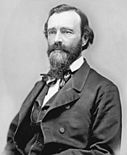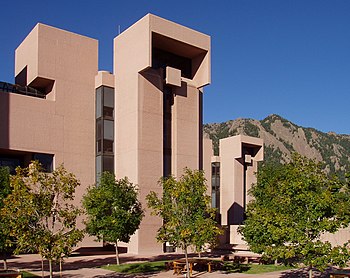Portal:Colorado
The Colorado Portal


WikiProject Colorado
You need not be either an expert or a resident.
You only need an active interest in the Centennial State.
Request an article about a Colorado topic here or volunteer here.
Colorado Events
- Wikimedia US Mountain West Spring 2024 online meeting, Tuesday, May 21, 2024, 8:00-9:00 PM MDT
- Wikimedia US Mountain West Summer 2024 online meeting, Tuesday, August 13, 2024, 8:00-9:00 PM MDT
- Wikimedia US Mountain West Autumn 2024 online meeting, Tuesday, November 12, 2024, 8:00-9:00 PM MST
Previous events:
|
|---|
Colorado events
|
Colorado Facts
- Date admitted to Union: August 1, 1876 (38th State)
- Demonym: Coloradan
- Capital: Denver
- Elected state officers:
- Governor: Jared Polis (D) (2019–)
- Lieutenant Governor: Dianne Primavera (D) (2019–)
- Secretary of State: Jena Griswold (D) (2019–)
- Treasurer: Dave Young (D) (2019–)
- Attorney General: Phil Weiser (D) (2019–)
- Colorado General Assembly:
- Colorado Senate:
- D-23 R-12 (2023–2024}
- Colorado House of Representatives:
- D-46 R-19 (2023–2024}
- Colorado Senate:
- Colorado Supreme Court:
- Brian Boatright, Chief Justice (2021–)
- Monica Márquez (2010-)
- William Hood, III (2014–)
- Richard Gabriel (2015–)
- Melissa Hart (2017–)
- Carlos Samour, Jr (2018–)
- Maria Berkenkotter (2021–)
- U.S. Senators:
- Class 2. John Hickenlooper (D) (2021–)
- Class 3. Michael Bennet (D) (2009–)
- 1. Diana DeGette (D) (1997–)
- 2. Joe Neguse (D) (2019–)
- 3. Lauren Boebert (R) (2021–2025)
- 4. vacant
- 5. Doug Lamborn (R) (2007–2025)
- 6. Jason Crow (D) (2019–)
- 7. Brittany Pettersen (D) (2023-)
- 8. Yadira Caraveo (D) (2023–)
- Total area: 104,094 square miles (269,602 km2) (eighth most extensive state)
- Highest elevation: Mount Elbert 14,440 feet (4,401.2 m) (third highest state)
- Mean elevation: 6,800 feet (2,070 m) (highest state)
- Lowest elevation: Arikaree River 3,317 feet (1,011 m) (highest state)
- Population (2020 census): 5,773,714 (21st most populous state)
- Population density: 55.47 per square mile (21.40 km−2) (39th most densely populated state)
- Number of counties: 64 counties (including two consolidated city and county governments)
- Number of municipalities: 273 municipalities, comprising 2 consolidated city and county governments, 73 cities, and 198 towns
- Time zone: MST=UTC−07, MDT=UTC−06
- USPS code: CO
- ISO 3166 code: US-CO
- Adjacent U.S. states: Wyoming, Nebraska, Kansas, Oklahoma, New Mexico, Arizona, Utah (tied for third most)
- State government website: Colorado.gov
- State tourism website: Colorado.com
State Symbols
Subcategories

This is a list of National Natural Landmarks in the U.S. state of Colorado.
There are 16 National Natural Landmarks in Colorado, one of which extends into Wyoming. They cover areas of geological, biological and historical importance, and include lakes, mountains, rock formations and numerous fossil sites. The landmarks are located in 14 of the state's 64 counties. Four counties each contain all or part of two NNLs, while two landmarks are split between two counties. The first two designations, Slumgullion Earthflow and Summit Lake, were made in 1965, while the most recent designation, Sulphur Cave and Spring, was made in 2021. Natural Landmarks in Colorado range from 60 to 380,000 acres (24.3 to 153,780.5 ha; 0.1 to 593.8 sq mi) in size. Owners include private individuals and several municipal, state and federal agencies. (Full article...)Selected mountain -
Selected biography -
Gilpin served as the first governor of the Colorado Territory. His administration was consumed largely with the defense of the new territory in the early days of the American Civil War and was brought down after only one year by scandalous financial dealings. After the demise of his political career, he made a large fortune as a land speculator in New Mexico, although his dealings were questionable and possibly illegal. (Full article...)
Selected article -
Independence Pass, originally known as Hunter Pass, is a high mountain pass in central Colorado, United States. It is at elevation 12,095 ft (3,687 m) on the Continental Divide in the Sawatch Range of the Rocky Mountains. The pass is midway between Aspen and Twin Lakes, on the border between Pitkin and Lake counties.
State Highway 82 traverses it, and after Cottonwood Pass to the south, is the second highest elevation of a paved Colorado state highway on a through road. It is also the second-highest pass with an improved road in the state, the fourth-highest paved road in the state and the second highest paved crossing of the Continental Divide in the U.S. Because of the heavy snowfall at its elevation, it is closed in wintertime, isolating Aspen from direct access from the east during the ski season. (Full article...)Selected image -
National Parks in Colorado
The 23 national parks in Colorado:
- Amache National Historic Site
- Arapaho National Recreation Area
- Bent's Old Fort National Historic Site
- Black Canyon of the Gunnison National Park
- Browns Canyon National Monument
- Camp Hale-Continental Divide National Monument
- Canyons of the Ancients National Monument
- Chimney Rock National Monument
- Colorado National Monument
- Continental Divide National Scenic Trail
- Curecanti National Recreation Area
- Dinosaur National Monument
- Florissant Fossil Beds National Monument
- Great Sand Dunes National Park and Preserve
- Hovenweep National Monument
- Mesa Verde National Park and World Heritage Site
- Old Spanish National Historic Trail
- Pony Express National Historic Trail
- Rocky Mountain National Park
- Sand Creek Massacre National Historic Site
- Santa Fe National Historic Trail
- Yucca House National Monument
Interesting facts-

- The official elevation of City and County of Denver is precisely one mile (5,280 feet = 1,609.344 m) above sea level. When the United States National Geodetic Survey determined that Denver was actually 36.10 inches (917 mm) higher than previously thought, the city merely lowered its elevation reference point on the west steps of the Colorado State Capitol by the difference to remain the Mile-High City. Most of Denver is actually more than one mile above sea level.
- The point where the Arikaree River flows out of the state at 3,317 feet (1,011 m) elevation is the lowest point in Colorado, and the highest low point of any U.S. state.
- The Town of Holly with a town center elevation of 3,392 feet (1,034 m) is the lowest municipality in Colorado.
- The City of Wray with a city center elevation of 3,566 feet (1,087 m) is the lowest incorporated city in Colorado.
- Denver is only the third highest U.S. state capital after Santa Fe, New Mexico, and Cheyenne, Wyoming.
- Denver is the highest U.S. city with a population of at least 600,000.
- Colorado Springs is the highest U.S. city with a population of at least 100,000.
- The mean elevation of Colorado is 6,800 feet (2,070 m), highest of all 50 U.S. states.
- The City of Leadville with a city center elevation of 10,152 feet (3,094 m) is the highest incorporated city in the United States.
- The Town of Alma with a town center elevation of 10,578 feet (3,224 m) is the highest incorporated town in the United States.
Did you know (auto-generated) -

- ... that Charles Johnson received the most votes for student body president at the University of Colorado Boulder, even though he had already been disqualified from running?
- ... that the 1976 Big Thompson River flood took place several hours before Colorado's 100th anniversary of statehood?
- ... that the No. 1–ranked 2023 Colorado Mines Orediggers, "college football's nerdiest contender", featured players with pigtails and a drawn-on blue mustache, a friar's haircut, and Harry Potter cosplay?
- ... that Aymara legislator Rafael Quispe's humorous style of political activism led one Bolivian parliamentarian to describe him as the "Chapulín Colorado" of the Legislative Assembly?
- ... that Yemi Mobolade is the first Black person and the first non-Republican to be elected the mayor of Colorado Springs, Colorado?
- ... that "The Potato King of Colorado" survived a shipwreck, mined for gold in Australia, and helped establish an alcohol-free Methodist colony?
- ... that Parkville lost out on becoming the Colorado Territory's capital by eleven votes and is now a ghost town largely buried under mining waste?
Related WikiProjects
Related portals
Resources
Associated Wikimedia
The following Wikimedia Foundation sister projects provide more on this subject:
-
Commons
Free media repository -
Wikibooks
Free textbooks and manuals -
Wikidata
Free knowledge base -
Wikinews
Free-content news -
Wikiquote
Collection of quotations -
Wikisource
Free-content library -
Wikiversity
Free learning tools -
Wikivoyage
Free travel guide -
Wiktionary
Dictionary and thesaurus























